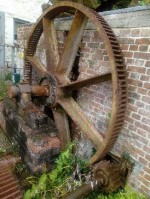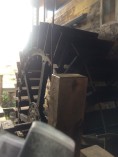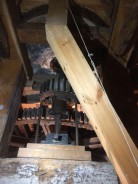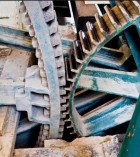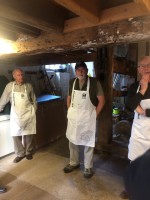
Cricklepit Mill Visit 9.11.18 & 12.12.18
The above wheel featured in our emails turned out not to be operational – although it is occasionally run when there is an overflow of water. Today was the quite different as there was an extreme water shortage as the entrance to the leat was being turned off for ongoing works to eliminate flooding.
The working wheel is within the building and doesn’t photograph so well but we examined it nevertheless and it was explained how the speed at which it turned depended on the water flow in the leat. The paddles on the underwater part of the wheel would be forced forward and upward and its central cog connected through a wall to operate all the indoor milling equipment via interconnecting wheels.
A farmer would bring in his corn to be milled in immensely heavy shoulder-high bags and these would be hoisted up to the top of the building by wheels and cogs connected to the main shaft. There it would be fed through a chute to a pair of horizontal wheels on the floor below. These crushed the corn to remove the husks which were often turned into animal feed. The grain is cracked between the millstones and gets finer and finer. It is then pushed down a further chute to which a bag had been tied to collect the flour. Extra fine flour can be achieved by adjusting friction of the wheels plus the top stone can be raised by 0.5 millimeter via an adjustment on the lower floor.
Sounds simple but there was a lot to go wrong. The mill can be thought of as an engine which provided power for a number of services, which in Exeter was primarily the processing of wool. This first water wheel is powered by water – in our case from a leat extending from the river near the Mill on the Exe pub, along Shilhay, under Western Way, past the carpark and into the mill. There were once 15 mills around here all working from the same pair of leats.
This first water wheel had a central “pole” which connected through the wall to a very complicated series of mill wheels. These operated the grinding stones on the floor above. In the photo on the right the interconnected wheels can just be seen. In the foreground can be seen the chute the finely ground flour comes down to be emptied into bags – as per 3rd para above.
These interconnecting wheels have teeth, one has wood and one has metal. When the two wheels turn and the teeth connect, the power is passed from one to another – just like the cogs on your grandfather’s watch!
Why are some teeth metal and others wood? The wooden teeth break easily but are similarly easy to fix. The metal teeth do not break but to have all metal teeth is dangerous. The room is full of flour dust and the slightest spark from two sets of metal teeth connecting would certainly start a fire. This happened often to those who were less careful.
The grinding stones on upper floor are therefore turned by the power which has come from the river, through the leat, through the wall and, via interconnecting wheels, to the floor above – where we watched the flour being produced.
A grist mill for flour would need 20 revs per minute of the water wheel to run all three millstones. If faster it would break up. At times in its history, the wheels operated hammers to pound wool – they called it pulling. And adjacent were open sided tentering sheds to re-shape the fabric stretched on hooks from floor to ceiling to dry in the wind.
Millstones needed to be sharpened every month so it was necessary to possess more than were needed i.e. always 2 in service while one was being sharpened. A millwright would visit regularly to re-cut the grooves in the stones. It is said that a good millwright had lots of bits of metal in his arms – from working with the wheels
Once every village had its mill but, as people gravitated to the big towns, larger town mills were needed. Steam power was being introduced into the factories so steam engines and roller mills were installed in the corn mills. But they get hot and destroy the vitamins etc in the flour. Shortage of grain was causing starvation but eventually the Corn Laws were repealed (in 1846) allowing grain to be brought in from abroad.
Cricklepit today produces 25 kilos of flour per month which it sells on site. The mill has been here since the 1200s and in 1250 the leat licence was granted. The mill continued to work - milling very different products, wool of course, and corn. In the 1990s there was a fire – from vandalism – but thankfully in 2004 the Devon Wildlife Trust negotiated to take over the building and reinstate the mill.
Visiting this mill was a great highlight. The millers demonstrated everything and explained every detail with incredible patience. We learnt so much and were so grateful for the demonstrations and explanations. We thanked the millers heartily.
